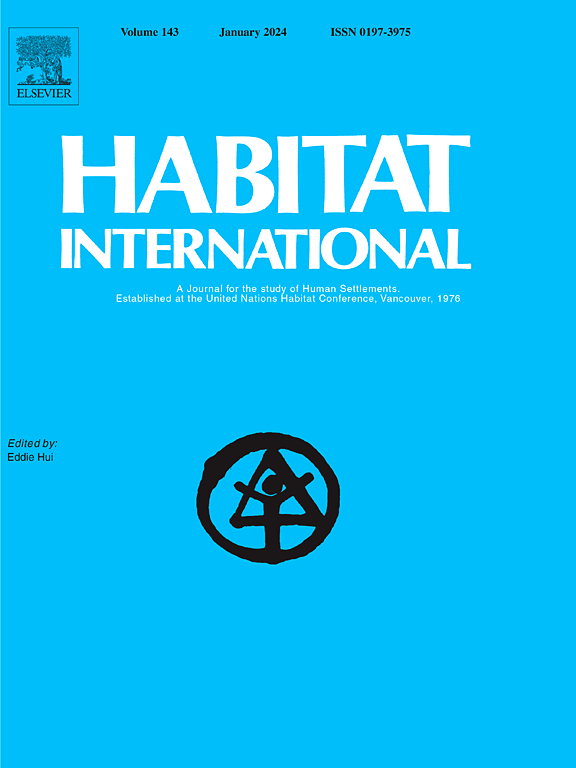Uncovering the edge urban villages using social media big data: A case study in Beijing, China
IF 6.5
1区 经济学
Q1 DEVELOPMENT STUDIES
引用次数: 0
Abstract
Spatial inequality in informal settlements has become a crucial issue in the sustainable development of global cities. Urban villages, emblematic of informal settlements in China, serve as focal points where migrant workers establish communities within urban areas. In recent years, the ongoing urban renewal and enhanced connectivity between urban centers and suburban areas have led to the progressive development of peri-urban informal settlements, which function as significant socio-spatial entities in the urban-rural continuum. This study introduces a concept of the Edge Urban Villages (EUVs) and applies it in a case study conducted in Beijing, China. EUVs are informal settlements located outside the physical urban area but serve traditional urban village functions, which play an important and as yet untouched role in serving migrants and sustainable urban development. Using systematic methods for analyzing social media big data, including conditional random field model, integrating natural language processing, geoparsing, and geocoding techniques, the locations and attention received by urban villages are identified. Moreover, the study outlines the spatial characteristics of EUVs based on their functions, utilizing a comprehensive dataset of 33,002 social media posts collected from various sources. The results indicate that: (1) 301 urban villages have been identified in Beijing, with over one third of them situated beyond the confines of the physical urban area, thus earning the designation of EUVs. (2) The proliferation of EUVs can be primarily attributed to the interdependence of their functions, encompassing rental services, public amenities, and transportation. However, the correlation between EUVs and their rural locale, measured by distance from urban centers, affluence levels, and land ownership types, lacks significance. (3) Although China has a strict urban-rural dichotomy in terms of population and land system, the rise of the EUVs identifies the fact that a large number of non-agricultural functions have emerged in the rural areas surrounding the big cities and maintain close functional links with the center cities. More attention should be directed towards EUVs, particularly concerning their emerging spatial inequality-related issues in the urban periphery.
利用社交媒体大数据挖掘城中村边缘:以中国北京为例
非正式住区的空间不平等已成为影响全球城市可持续发展的关键问题。城中村是中国非正式住区的象征,是农民工在城市地区建立社区的中心。近年来,持续的城市更新和城市中心与郊区之间的连通性增强导致了城市周边非正式住区的逐步发展,这些住区在城乡连续体中发挥着重要的社会空间实体作用。本研究引入了边缘城中村的概念,并将其应用于中国北京的一个案例研究中。euv是位于城市实体地区之外的非正式住区,但具有传统的城中村功能,在服务移徙者和可持续城市发展方面发挥着重要但尚未触及的作用。利用系统的方法分析社交媒体大数据,包括条件随机场模型,整合自然语言处理、地质解析和地理编码技术,确定城中村的位置和受到的关注。此外,该研究利用从各种来源收集的33,002个社交媒体帖子的综合数据集,根据euv的功能概述了其空间特征。结果表明:(1)北京共确定了301个城中村,其中超过三分之一的城中村位于城市实体区域之外,因此获得了euv的称号。(2) euv的激增主要是由于其功能的相互依赖,包括租赁服务、公共设施和交通。然而,通过与城市中心的距离、富裕水平和土地所有权类型来衡量,euv与农村地区之间的相关性缺乏显著性。(3)尽管中国在人口和土地制度上实行严格的城乡二元制度,但城市中心城市的兴起表明,大城市周边农村地区出现了大量的非农功能,并与中心城市保持着密切的功能联系。应该更多地关注euv,特别是在城市外围出现的与空间不平等相关的问题。
本文章由计算机程序翻译,如有差异,请以英文原文为准。
求助全文
约1分钟内获得全文
求助全文
来源期刊

Habitat International
Multiple-
CiteScore
10.50
自引率
10.30%
发文量
151
审稿时长
38 days
期刊介绍:
Habitat International is dedicated to the study of urban and rural human settlements: their planning, design, production and management. Its main focus is on urbanisation in its broadest sense in the developing world. However, increasingly the interrelationships and linkages between cities and towns in the developing and developed worlds are becoming apparent and solutions to the problems that result are urgently required. The economic, social, technological and political systems of the world are intertwined and changes in one region almost always affect other regions.
 求助内容:
求助内容: 应助结果提醒方式:
应助结果提醒方式:


